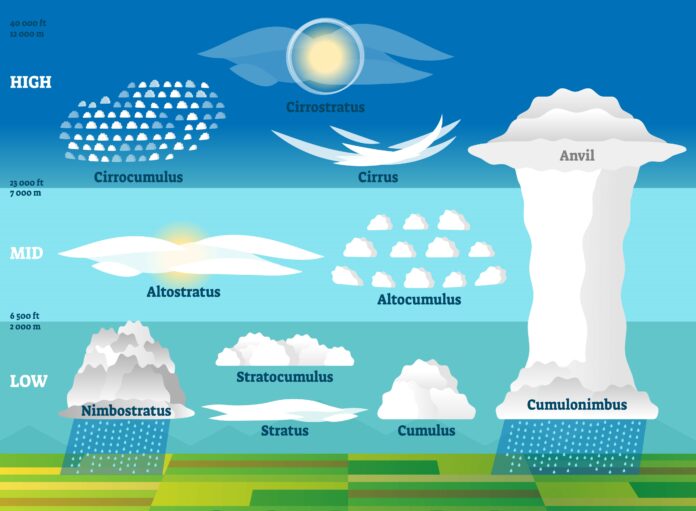
Types of cloud – Clouds are fascinating; they are not what they appear to be, which makes them even more interesting. Clouds appear like a fluffy, soft bed in the sky; however, if you ever try to step into one, you will fall through and be hit by water droplets all over.
Clouds are fleeting, fragile, yet very powerful. Cloud can instantly change the fair weather into an angry and hail-producing rain cloud. Clouds are fun to observe, and you can soon learn to make connections about weather conditions.
In this guide, we will take a look at different types of cloud. Yes, you read it right; there is not one type of cloud; instead multiple types.
How are Clouds named?
Clouds are names on their basic shapes, their height in the sky, and whether they produce rain or precipitation. Tighten your seatbelt to dive into the cloudy world.
The shapes :
Strato means forming a layer of a blanket to cover the sky
Cumulo means heap or pile of cotton in the sky
Cirro is like a curl of hair in the sky.
The heights:
High / Cirro – height above 20,000ft
Middle/ Alto meaning mid height 6500ft
Low clouds under 6500 ft
Nimbus stands for “rain” or “precipitation.”
Naming a cloud is usually a combination of Latin roots. For instance:
Name the high-level blanket look-a-like cloud.
High + blanket = Cirro+stratus
Cirrostratus
Now you see, naming a type of cloud is so much fun. There are so many different types of clouds, but the most basic are three cloud types.
What can clouds tell us about the weather?
One reason to feel motivated to learn about clouds is that they can teach you so much more about whether if you know different types of clouds.
Learning about the weather can be complex, and here we have a small sample to help you understand more about it.
Below we have listed three main types of cloud and their meaning in the sky. Your trick of Latin code names will come in handy here.
Cumulus
Cumulus is white puffy cotton-looking clouds that appear soft like angels roaming around. These are low-level clouds (below 6500 ft); however, some can go past 20,000ft.
Cumulus is seen in many different types, and here we have a few of them.
Cumulus humilis is a flat bottom, puffy cotton cloud. These are randomly scattered through the sky in separate piles and indicate “fair weather,” which means moderate temperature and no precipitation.
They are named humilis because of the tiny and non-threatening cumulus. If you see pleasant weather, you will be happy to spot Cumulus Humilis.
Stratus
Stratus is a low-level cloud that covers the entire sky like a blanket. These do not produce precipitation often; if they do, it is like a misty drizzle. These clouds are associated with “curling up in your blanket with a hot cup of coffee and reading a book” weather.
Cirrus
Another type of cloud is Cirrus. These are located above 20,000 ft and are made of icy crystals. These delicate-looking wispy clouds come in frontal systems and signify changing weather.
Cirrus in the sky looks like a whimsical painting.
Why are clouds flat on the bottom?
The first chunk of the cloud is pushed up when the air rises, forming more clouds beneath. This process results in a puffy cloud shape on top and a flat on the bottom. This level is known as the convective condensation level (ccl) or lifting condensation level (LCL), depending on the lifting mechanism.
Conclusion:
There are many different types of clouds; not many people know this. Not only are the types of cloud but also the names of clouds. The clouds are named in Latin code words, which are fun and easy to learn. Learning about clouds can be a great help in identifying the weather. Hope this article helped to embed curiosity in your minds about clouds.
















